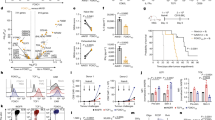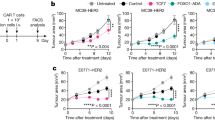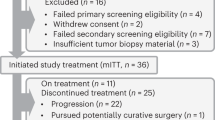Abstract
The transfer of T cell receptor (TCR) genes can be used to induce immune reactivity toward defined antigens to which endogenous T cells are insufficiently reactive. This approach, which is called TCR gene therapy, is being developed to target tumors and pathogens, and its clinical testing has commenced in patients with cancer. In this study we show that lethal cytokine-driven autoimmune pathology can occur in mouse models of TCR gene therapy under conditions that closely mimic the clinical setting. We show that the pairing of introduced and endogenous TCR chains in TCR gene-modified T cells leads to the formation of self-reactive TCRs that are responsible for the observed autoimmunity. Furthermore, we demonstrate that adjustments in the design of gene therapy vectors and target T cell populations can be used to reduce the risk of TCR gene therapy–induced autoimmune pathology.
This is a preview of subscription content, access via your institution
Access options
Subscribe to this journal
Receive 12 print issues and online access
$209.00 per year
only $17.42 per issue
Buy this article
- Purchase on Springer Link
- Instant access to full article PDF
Prices may be subject to local taxes which are calculated during checkout






Similar content being viewed by others
References
Rosenberg, S.A. Progress in human tumour immunology and immunotherapy. Nature 411, 380–384 (2001).
Theobald, M. et al. Tolerance to p53 by A2.1-restricted cytotoxic T lymphocytes. J. Exp. Med. 185, 833–841 (1997).
Romieu, R. et al. Passive but not active CD8+ T cell–based immunotherapy interferes with liver tumor progression in a transgenic mouse model. J. Immunol. 161, 5133–5137 (1998).
Schumacher, T.N. T-cell-receptor gene therapy. Nat. Rev. Immunol. 2, 512–519 (2002).
Gattinoni, L., Powell, D.J. Jr., Rosenberg, S.A. & Restifo, N.P. Adoptive immunotherapy for cancer: building on success. Nat. Rev. Immunol. 6, 383–393 (2006).
Varela-Rohena, A. et al. Control of HIV-1 immune escape by CD8 T cells expressing enhanced T-cell receptor. Nat. Med. 14, 1390–1395 (2008).
Morris, E.C., Tsallios, A., Bendle, G.M., Xue, S. & Stauss, H.J. A critical role of T cell antigen receptor-transduced MHC class I–restricted helper T cells in tumour protection. Proc. Natl. Acad. Sci. USA 102, 7934–7939 (2005).
de Witte, M.A. et al. TCR gene therapy of spontaneous prostate carcinoma requires in vivo T cell activation. J. Immunol. 181, 2563–2571 (2008).
de Witte, M.A. et al. Requirements for effective antitumor responses of TCR transduced T cells. J. Immunol. 181, 5128–5136 (2008).
Morgan, R.A. et al. Cancer regression in patients after transfer of genetically engineered lymphocytes. Science 314, 126–129 (2006).
Johnson, L.A. et al. Gene therapy with human and mouse T-cell receptors mediates cancer regression and targets normal tissues expressing cognate antigen. Blood 114, 535–546 (2009).
de Witte, M.A. et al. Targeting self-antigens through allogeneic TCR gene transfer. Blood 108, 870–877 (2006).
Kaneko, S. et al. IL-7 and IL-15 allow the generation of suicide gene–modified alloreactive self-renewing central memory human T lymphocytes. Blood 113, 1006–1015 (2009).
Overwijk, W.W. et al. Tumor regression and autoimmunity after reversal of a functionally tolerant state of self-reactive CD8+ T cells. J. Exp. Med. 198, 569–580 (2003).
Shrikant, P. & Mescher, M.F. Opposing effects of IL-2 in tumor immunotherapy: promoting CD8 T cell growth and inducing apoptosis. J. Immunol. 169, 1753–1759 (2002).
Kieback, E., Charo, J., Sommermeyer, D., Blankenstein, T. & Uckert, W. A safeguard eliminates T cell receptor gene–modified autoreactive T cells after adoptive transfer. Proc. Natl. Acad. Sci. USA 105, 623–628 (2008).
Jorritsma, A. et al. Selecting highly affine and well-expressed TCRs for gene therapy of melanoma. Blood 110, 3564–3572 (2007).
Kessels, H.W., Wolkers, M.C., van den Boom, M.D., van der Valk, M.A. & Schumacher, T.N. Immunotherapy through TCR gene transfer. Nat. Immunol. 2, 957–961 (2001).
Thomas, D.A. & Massague, J. TGF-β directly targets cytotoxic T cell functions during tumor evasion of immune surveillance. Cancer Cell 8, 369–380 (2005).
Gorelik, L. & Flavell, R.A. Immune-mediated eradication of tumors through the blockade of transforming growth factor-β signaling in T cells. Nat. Med. 7, 1118–1122 (2001).
Bendle, G.M., Haanen, J.B. & Schumacher, T.N. Preclinical development of T cell receptor gene therapy. Curr. Opin. Immunol. 21, 209–214 (2009).
Sebestyén, Z. et al. Human TCR that incorporate CD3ζ induce highly preferred pairing between TCRα and β chains following gene transfer. J. Immunol. 180, 7736–7746 (2008).
Willemsen, R.A. et al. Grafting primary human T lymphocytes with cancer-specific chimeric single chain and two chain TCR. Gene Ther. 7, 1369–1377 (2000).
Voss, R.H. et al. Molecular design of the Cαβ interface favors specific pairing of introduced TCRαβ in human T cells. J. Immunol. 180, 391–401 (2008).
Cohen, C.J., Zhao, Y., Zheng, Z., Rosenberg, S.A. & Morgan, R.A. Enhanced antitumor activity of murine-human hybrid T-cell receptor (TCR) in human lymphocytes is associated with improved pairing and TCR/CD3 stability. Cancer Res. 66, 8878–8886 (2006).
Cohen, C.J. et al. Enhanced antitumor activity of T cells engineered to express T-cell receptors with a second disulfide bond. Cancer Res. 67, 3898–3903 (2007).
Kuball, J. et al. Facilitating matched pairing and expression of TCR chains introduced into human T cells. Blood 109, 2331–2338 (2007).
Heemskerk, M.H. et al. Reprogramming of virus-specific T cells into leukemia-reactive T cells using T cell receptor gene transfer. J. Exp. Med. 199, 885–894 (2004).
Weinhold, M., Sommermeyer, D., Uckert, W. & Blankenstein, T. Dual T cell receptor expressing CD8+ T cells with tumor- and self-specificity can inhibit tumor growth without causing severe autoimmunity. J. Immunol. 179, 5534–5542 (2007).
Thomas, S. et al. Targeting the Wilms tumor antigen 1 by TCR gene transfer: TCR variants improve tetramer binding but not the function of gene modified human T cells. J. Immunol. 179, 5803–5810 (2007).
Uckert, W. & Schumacher, T.N. TCR transgenes and transgene cassettes for TCR gene therapy: status in 2008. Cancer Immunol. Immunother. 58, 809–822 (2009).
Greenbaum, B.H. Transfusion-associated graft-versus-host disease: historical perspectives, incidence, and current use of irradiated blood products. J. Clin. Oncol. 9, 1889–1902 (1991).
Schroeder, M.L. Transfusion-associated graft-versus-host disease. Br. J. Haematol. 117, 275–287 (2002).
Agbaht, K., Altintas, N.D., Topeli, A., Gokoz, O. & Ozcebe, O. Transfusion-associated graft-versus-host disease in immunocompetent patients: case series and review of the literature. Transfusion 47, 1405–1411 (2007).
Bloom, M.L. et al. A mouse model of lymphocyte infusion-induced bone marrow failure. Exp. Hematol. 32, 1163–1172 (2004).
Tang, Y., Desierto, M.J., Chen, J. & Young, N.S. The role of the TH1 transcription factor T-bet in a mouse model of immune-mediated bone-marrow failure. Blood 115, 541–548 (2010).
Kolen, S. et al. Biodistribution and retention time of retrovirally labeled T lymphocytes in mice is strongly influenced by the culture period before infusion. J. Immunother. 25, 385–395 (2002).
Gattinoni, L. et al. Acquisition of full effector function in vitro paradoxically impairs the in vivo antitumor efficacy of adoptively transferred CD8+ T cells. J. Clin. Invest. 115, 1616–1626 (2005).
Zhou, J. et al. Telomere length of transferred lymphocytes correlates with in vivo persistence and tumor regression in melanoma patients receiving cell transfer therapy. J. Immunol. 175, 7046–7052 (2005).
Schreurs, M.W. et al. Dendritic cells break tolerance and induce protective immunity against a melanocyte differentiation antigen in an autologous melanoma model. Cancer Res. 60, 6995–7001 (2000).
Kessels, H.W., Schepers, K., van den Boom, M.D., Topham, D.J. & Schumacher, T.N. Generation of T cell help through a MHC class I-restricted TCR. J. Immunol. 177, 976–982 (2006).
Acknowledgements
We thank the Experimental Animal Department for animal husbandry, H. van Tinteren for advice on statistical analysis and R. Gomez for experimental assistance. We are grateful to A. Pfauth and F. van Diepen for assistance with flow cytometry. G.M.B. is supported by a Leukaemia and Lymphoma Research Travel Fellowship (06037). C.L. is a fellow in the PhD Fellowship Program of Boehringer Ingelheim Fonds-Foundation for Basic Research in Biomedicine. T.N.M.S. and J.B.A.G.H. are supported by grants from The Netherlands Organization for Scientific Research (431-00-005), the Dutch Cancer Society (NKI 2009-4282 and 2003-2860), The Landsteiner Foundation for Blood Transfusion Research (04-08) and FP6 Integrated Project Adoptive T cell Targeting to Activate Cancer Killing (ATTACK). Cytotoxic T lymphocyte clone LP9 was kindly provided by G. Adema (Radboud University).
Author information
Authors and Affiliations
Contributions
G.M.B. designed experiments, performed experiments, analyzed and interpreted data and wrote the paper. C.L. designed experiments, performed experiments, analyzed and interpreted data and wrote the paper. A.I.H. designed experiments, performed experiments, analyzed and interpreted data. L.B. performed experiments and analyzed data. M.A.d.W. and A.J. made the initial observation of cachexia and rapid death of mice in mouse models of TCR gene therapy. A.D.M.K. performed experiments and interpreted data. N.P. and R.D. generated and provided the TRP2 TCR sequences. E.K. and W.U. provided the Tag-specific mAb and advice on in vivo depletion. J.-Y.S. performed experiments and analyzed data. J.B.A.G.H. interpreted data. T.N.M.S. designed experiments, interpreted data and wrote the paper.
Corresponding authors
Ethics declarations
Competing interests
The authors declare no competing financial interests.
Supplementary information
Supplementary Text and Figures
Supplementary Figures 1–7, Supplementary Table 1 and Supplementary Methods (PDF 2142 kb)
Rights and permissions
About this article
Cite this article
Bendle, G., Linnemann, C., Hooijkaas, A. et al. Lethal graft-versus-host disease in mouse models of T cell receptor gene therapy. Nat Med 16, 565–570 (2010). https://doi.org/10.1038/nm.2128
Received:
Accepted:
Published:
Issue Date:
DOI: https://doi.org/10.1038/nm.2128
This article is cited by
-
Challenges and new technologies in adoptive cell therapy
Journal of Hematology & Oncology (2023)
-
CRISPR/Cas9 therapeutics: progress and prospects
Signal Transduction and Targeted Therapy (2023)
-
T cell receptor therapeutics: immunological targeting of the intracellular cancer proteome
Nature Reviews Drug Discovery (2023)
-
TCR engineered T cells for solid tumor immunotherapy
Experimental Hematology & Oncology (2022)
-
T-cell receptor-based therapy: an innovative therapeutic approach for solid tumors
Journal of Hematology & Oncology (2021)



